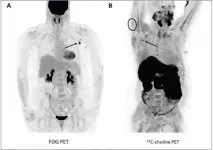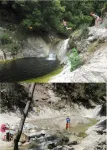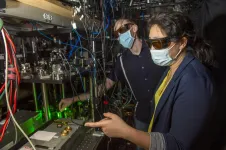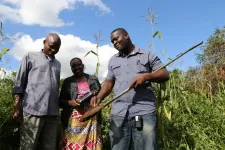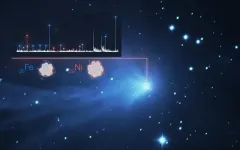A revolutionary method to drastically reduce stray light on space telescopes
2021-05-19
(Press-News.org) A team of researchers at the Centre Spatial de Liège (CSL) of the University of Liège has just developed a method to identify the contributors and origins of stray light on space telescopes. This is a major advance in the field of space engineering that will help in the acquisition of even finer space images and the development of increasingly efficient space instruments. This study has just been published in the journal Scientific Reports.
Space telescopes are becoming more and more powerful. Technological developments in recent years have made it possible, for example, to observe objects further and further into the universe or to measure the composition of the Earth's atmosphere with ever greater precision. However, there is still one factor limiting the performance of these telescopes: stray light. A phenomenon that has been known fora long time, stray light results in light reflections (ghost reflections between lenses, scattering, etc.) that damage the quality of images and often lead to blurred images. Until now, the methods for checking and characterizing this stray light during the development phase of the telescopes have been very limited, making it possible to "just" know whether or not the instrument was sensitive to the phenomenon, forcing engineers to revise all their calculations in positive cases, leading to considerable delays in the commissioning of these advanced tools.
Researchers at the Centre Spatial de Liège (CSL), in collaboration with the University of Strasbourg, have just developed a revolutionary method for solving this problem by using a femto-second pulsed laser to send light beams to illuminate the telescope. "Stray light rays take (in the telescope) different optical paths from the rays that form the image," explains Lionel Clermont, an expert in space optical systems and stray light at CSL. Thanks to this, and using an ultra-fast detector (of the order of 10-9 seconds of resolution, i.e. a thousandth of a millionth of a second), we are measuring the image and the different stray light effects at different times. In addition to this decomposition, we can identify each of the contributors using their arrival times, which are directly related to the optical path, and thus know the origin of the problem." The CSL engineers have now demonstrated the effectiveness of this method in a paper, just published in the journal Scientific Reports, in which they present the first film showing ghost reflections in a refractive telescope arriving at different times. "We have also been able to use these measurements to reverse engineer theoretical models," says Lionel Clermont, "which will make it possible, for example, to build better image processing models in the future." By correlating these measurements with numerical models, the scientists will now be able to determine precisely the origin of the stray light and thus act accordingly to improve the system, both by improving the hardware and with the development of correction algorithms.
More than just a scientific curiosity, this method developed at the CSL could well lead to a small revolution in the field of high-performance space instruments. "We have already received a great deal of interest from the ESA (European Space Agency) and from industrialists in the space sector," says Marc Georges, an expert in metrology and lasers at CSL and co-author of the study. This method responds to an urgent problem that has been unresolved until now." In the near future, CSL researchers intend to continue the development of this method, to increase its TRL (Technology Readiness Level) and bring it to an industrial level. An industrial application is already planned for the FLEX (Fluorescence Explorer) project, an earth observation telescope that is part of ESA's Living Planet Program. The researchers hope to be able to apply it to scientific instruments as well.
INFORMATION:
ELSE PRESS RELEASES FROM THIS DATE:
2021-05-19
HAMILTON, ON (May 19, 2021) - Researchers have found that the inclusion of a third drug to commonly used dual-drug inhalers can reduce asthma exacerbations and improve control over the disease in children, adolescents, and adults with moderate-to-severe asthma.
A team from McMaster University and The Research Institute of St. Joe's Hamilton announced their findings from a systematic review and meta-analysis. Data from 20 randomized controlled trials, which included a total of almost 12,000 patients, were analyzed in the study.
Dual-drug inhalers used to treat asthma typically contain an inhaled corticosteroid (ICS) to reduce inflammation, as well as a long-acting beta-adrenoceptor agonist (LABA) that acts as a bronchodilator. High-certainty evidence showed that the inclusion of a third ...
2021-05-19
Leesburg, VA, May 19, 2021--According to an open-access article in ARRS' American Journal of Roentgenology (AJR), increased axillary lymph node or ipsilateral deltoid uptake is occasionally observed on FDG or 11C-choline PET performed after Pfizer-BioNTech or Moderna COVID-19 vaccination.
"Recognition of occasional abnormal axillary lymph node or deltoid uptake on PET examinations performed after COVID-19 vaccination will aid interpreting physicians and reduce unnecessary biopsies," wrote corresponding author Jason R. Young from the department of radiology at Mayo Clinic in Rochester, MN.
Young and colleagues' retrospective study included ...
2021-05-19
For the first time, geological records have been used to reconstruct the history of Larsen C Ice Shelf in Antarctica. The ice shelf is the largest remaining remnant of a much more extensive area of ice on the Antarctic Peninsula that began to break up during the 1990s (Larsen A), and saw a huge collapse in 2002 (Larsen B). This new reconstruction enables scientists to better understand if and when the remaining ice shelf could collapse in the future.
Publishing this month in the journal Geology an international team describes how the largest remaining ice shelf on the Antarctic ...
2021-05-19
By mapping its genetic underpinnings, researchers at University of California San Diego School of Medicine have identified a predictive causal role for specific cell types in type 1 diabetes, a condition that affects more than 1.6 million Americans.
The findings are published in the May 19, 2021 online issue of Nature.
Type 1 diabetes is a complex autoimmune disease characterized by the impairment and loss of insulin-producing pancreatic beta cells and subsequent hyperglycemia (high blood sugar), which is damaging to the body and can cause other serious health problems, such as heart disease and vision loss. Type 1 is less common than type 2 diabetes, but its prevalence is growing. The U.S. Centers for Disease ...
2021-05-19
Boulder, Colo., USA: Deep pools below waterfalls are popular recreational swimming spots, but sometimes they can be partially or completely filled with sediment. New research showed how and why pools at the base of waterfalls, known as plunge pools, go through natural cycles of sediment fill and evacuation. Beyond impacting your favorite swimming hole, plunge pools also serve important ecologic and geologic functions. Deep pools are refuges for fish and other aquatic animals in summer months when water temperatures in shallow rivers can reach lethal levels. Waterfalls also can liquefy sediment within the pool, potentially triggering debris flows that can damage property and threaten ...
2021-05-19
Florida State University researchers have more insight into a strange sea creature found in oceans around the world and what their presence means for the health of a marine ecosystem.
Scientists have thought that salps -- small marine organisms that look like clear, gelatinous blobs -- competed for resources with krill, shrimp-like creatures that are an important food source for many marine animals. But new research published in Limnology and Oceanography suggests that salps are actually competing for food with an organism known as a protist.
An image of a salp taken during research. New research published in Limnology and Oceanography suggests that salps are actually competing for food with an organism known as a protist. (Courtesy of ...
2021-05-19
A heart surgeon doesn't need to grasp quantum mechanics to perform successful operations. Even chemists don't always need to know these fundamental principles to study chemical reactions. But for Kang-Kuen Ni, the Morris Kahn associate professor of chemistry and chemical biology and of physics, quantum spelunking is, like space exploration, a quest to discover a vast and mysterious new realm.
Today, much of quantum mechanics is explained by Schrödinger's equation, a kind of master theory that governs the properties of everything on Earth. "Even though ...
2021-05-19
The amount of nutrients people get from the crops that they eat is a type of 'postcode lottery', according to new research that has analysed thousands of cereal grains and soils as part of a project to tackle hidden hunger in Malawi and Ethiopia.
A global team led by the University of Nottingham and its Future Food Beacon including academics and researchers from Addis Ababa University (AAU) in Ethiopia and Lilongwe University of Agriculture and Natural Resources (LUANAR) in Malawi, working on the GeoNutrition project, have discovered more about the relation between soils, crops and micronutrient deficiencies among people living there. Their ...
2021-05-19
HERSHEY, Pa. -- Parkinson's disease is the second most common neurodegenerative disease and affects more than 10 million people around the world. To better understand the origins of the disease, researchers from Penn State College of Medicine and The Hebrew University of Jerusalem have developed an integrative approach, combining experimental and computational methods, to understand how individual proteins may form harmful aggregates, or groupings, that are known to contribute to the development of the disease. They said their findings could guide the development of new therapeutics to delay or even halt the progression of neurodegenerative diseases.
Alpha-synuclein ...
2021-05-19
A new study by a Belgian team using data from the European Southern Observatory's Very Large Telescope (ESO's VLT) has shown that iron and nickel exist in the atmospheres of comets throughout our Solar System, even those far from the Sun. A separate study by a Polish team, who also used ESO data, reported that nickel vapour is also present in the icy interstellar comet 2I/Borisov. This is the first time heavy metals, usually associated with hot environments, have been found in the cold atmospheres of distant comets.
"It was a big surprise to detect iron and nickel atoms in the atmosphere of all the comets ...
LAST 30 PRESS RELEASES:
[Press-News.org] A revolutionary method to drastically reduce stray light on space telescopes
